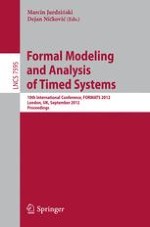2012 | Buch
Formal Modeling and Analysis of Timed Systems
10th International Conference, FORMATS 2012, London, UK, September 18-20, 2012. Proceedings
herausgegeben von: Marcin Jurdziński, Dejan Ničković
Verlag: Springer Berlin Heidelberg
Buchreihe : Lecture Notes in Computer Science
